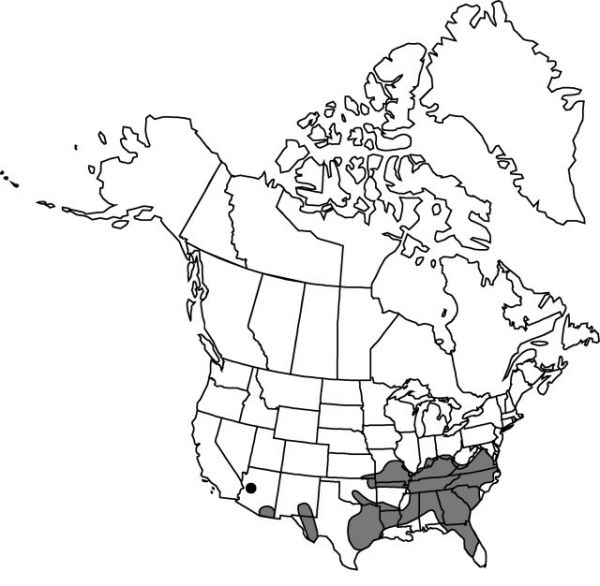Difference between revisions of "Hexalectris spicata var. spicata"
FNA>Volume Importer |
FNA>Volume Importer |
||
| Line 8: | Line 8: | ||
|name=Bletia aphylla | |name=Bletia aphylla | ||
|authority=Nuttall | |authority=Nuttall | ||
| − | }}{{Treatment/ID/Synonym | + | }} {{Treatment/ID/Synonym |
|name=Hexalectris aphylla | |name=Hexalectris aphylla | ||
|authority=(Nuttall) Rafinesque | |authority=(Nuttall) Rafinesque | ||
| − | }}{{Treatment/ID/Synonym | + | }} {{Treatment/ID/Synonym |
|name=Hexalectris squamosa | |name=Hexalectris squamosa | ||
|authority=Rafinesque | |authority=Rafinesque | ||
| Line 29: | Line 29: | ||
|elevation=0–600 m (c Texas eastward and northward), 1600–2000 m (west) | |elevation=0–600 m (c Texas eastward and northward), 1600–2000 m (west) | ||
|distribution=Ala.;Ariz.;Ark.;Fla.;Ga.;Ill.;Ind.;Kans.;Ky.;La.;Md.;Miss.;Mo.;N.Mex.;N.C.;Ohio;Okla.;S.C.;Tenn.;Tex.;Va.;W.Va.;Mexico. | |distribution=Ala.;Ariz.;Ark.;Fla.;Ga.;Ill.;Ind.;Kans.;Ky.;La.;Md.;Miss.;Mo.;N.Mex.;N.C.;Ohio;Okla.;S.C.;Tenn.;Tex.;Va.;W.Va.;Mexico. | ||
| − | |discussion=<p>Hexalectris spicata var. spicata occurs in Missouri in calcareous soil in dry forests and limestone glades, often in association with Juniperus in the latter habitat (G. Yatskievych 1999). Detailed descriptions of habitat and associated species for H. spicata var. spicata in Illinois are given by C. J. Sheviak (1974) and for Indiana by M. A. Homoya (1993).</p><!-- | + | |discussion=<p><i>Hexalectris spicata </i>var.<i> spicata</i> occurs in Missouri in calcareous soil in dry forests and limestone glades, often in association with <i>Juniperus</i> in the latter habitat (G. Yatskievych 1999). Detailed descriptions of habitat and associated species for <i>H. spicata </i>var.<i> spicata</i> in Illinois are given by C. J. Sheviak (1974) and for Indiana by M. A. Homoya (1993).</p><!-- |
| − | --><p>In Oklahoma, populations of Hexalectris spicata var. spicata growing in decaying Juniperus needle litter over sandstone are far more robust.</p> | + | --><p>In Oklahoma, populations of <i>Hexalectris spicata </i>var.<i> spicata</i> growing in decaying <i>Juniperus</i> needle litter over sandstone are far more robust.</p> |
|tables= | |tables= | ||
|references= | |references= | ||
| Line 54: | Line 54: | ||
|publication year= | |publication year= | ||
|special status= | |special status= | ||
| − | |source xml=https://jpend@bitbucket.org/aafc-mbb/fna-data-curation.git/src/ | + | |source xml=https://jpend@bitbucket.org/aafc-mbb/fna-data-curation.git/src/8f726806613d60c220dc4493de13607dd3150896/coarse_grained_fna_xml/V26/V26_1234.xml |
|subfamily=Orchidaceae subfam. Epidendroideae | |subfamily=Orchidaceae subfam. Epidendroideae | ||
|tribe=Orchidaceae tribe Arethuseae | |tribe=Orchidaceae tribe Arethuseae | ||
Revision as of 16:41, 18 September 2019
Stems yellow-brown, pink-brown, to purple, 25–80 cm. Flowers chasmogamous; sepals and petals often apically recurved, yellow-tan to purple-brown with prominent purple or brown veins; dorsal sepal oblong-elliptic, obtuse, 15–24 × 4–8 mm; lateral sepals 14–20 × 5.5–9 mm; petals 14–23 × 5–9 mm; lip tan to purple-white, rarely entirely white, 13–20 × 8–16 mm; lamellae central, purple, 0.7–1 mm; column 13–18 mm; rostellum present; anthers yellow. Capsules 16–30 × 8–20 mm.
Phenology: Flowering Apr–Aug.
Habitat: Humus, typically in mesic to dry soil over limestone or sandstone, in vicinity of Juniperus, Pinus, or Quercus
Elevation: 0–600 m (c Texas eastward and northward), 1600–2000 m (west)
Distribution

Ala., Ariz., Ark., Fla., Ga., Ill., Ind., Kans., Ky., La., Md., Miss., Mo., N.Mex., N.C., Ohio, Okla., S.C., Tenn., Tex., Va., W.Va., Mexico.
Discussion
Hexalectris spicata var. spicata occurs in Missouri in calcareous soil in dry forests and limestone glades, often in association with Juniperus in the latter habitat (G. Yatskievych 1999). Detailed descriptions of habitat and associated species for H. spicata var. spicata in Illinois are given by C. J. Sheviak (1974) and for Indiana by M. A. Homoya (1993).
In Oklahoma, populations of Hexalectris spicata var. spicata growing in decaying Juniperus needle litter over sandstone are far more robust.
Selected References
None.